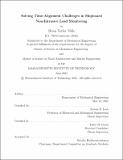Solving Time-Alignment Challenges in Shipboard Non-Intrusive Load Monitoring
Author(s)
Mills, Brian Taylor
DownloadThesis PDF (76.25Mb)
Advisor
Leeb, Steven B.
Green, Daisy H.
Terms of use
Metadata
Show full item recordAbstract
Non-intrusive load monitoring is the practice of using sensors placed on power cables to monitor downstream loads. A few sensors can provide monitoring of many different loads,making it very cost-effective. Ship requirements for redundancy require multiple generators,and some go beyond a typical radial distribution system to a ring or zonal distribution system. It is not possible for one sensor to monitor the entire ship; multiple sensors are necessary. To preserve the transients necessary for load identification, all sensors must be time-aligned. This thesis presents several options for time-alignment inherent to the power stream itself, forgoing use of external systems: tracking voltage zero-crossings, matching voltage frequency and amplitude patterns, individual power transient alignment, and a closed system reconstruction artifact-minimization. Recent non-intrusive load monitor (NILM)installations onboard USCGC MARLIN (WPB 87304) and USS INDIANAPOLIS (LCS 17)are documented, identifying and analyzing various loads. USCGC MARLIN marks the first and so far only time NILM has monitored an entire ship vice specific power panels. NILM-assisted Electric Power Load Analysis (EPLA) is demonstrated on USS INDIANAPOLIS.
Date issued
2021-06Department
Massachusetts Institute of Technology. Department of Mechanical EngineeringPublisher
Massachusetts Institute of Technology